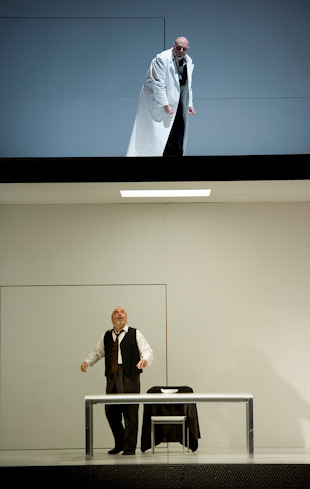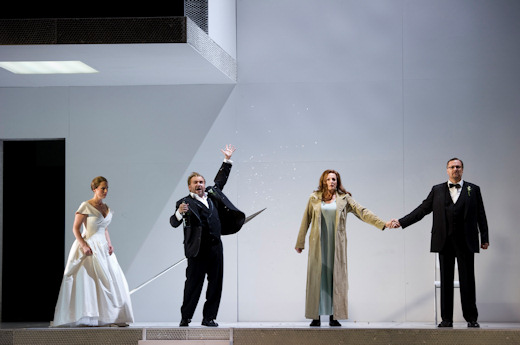Other Links
Editorial Board
- UK Editors
- Roger Jones and John Quinn
Editors for The Americas - Bruce Hodges and Jonathan Spencer Jones
European Editors - Bettina Mara and Jens F Laurson
Consulting Editor - Bill Kenny
Assistant Webmaster -Stan Metzger
Founder - Len Mullenger
Google Site Search
SEEN AND HEARD INTERNATIONAL OPERA REVIEW
Wagner, G�tterd�mmerung: (New production) Soloists, Hamburg
Philharmonic Orchestra. Conductor: Simone Young. Staatsoper Hamburg.
21.11.2010 (JPr)
Production by Claus Guth, Lighting by Michael Bauer, Sets and Costumes by
Christian Schmidt.

For me - nearly a year to the day after Siegfried I returned to Hamburg to
see how the new Ring Cycle ends. The programme book had quote after quote from
philosophers and other significant figures that seem important to Claus Guth,
the director, and his dramaturg, Hella Bartnig. Probably amongst them is the
explanation for Guth's 'vision' but as individually staged since 2008 there
seems little to link the individual operas and his world ends with a whimper
and not the bang it needs. Perhaps all will be revealed to those seeing the
complete cycles early next year?
So, how does this G�tterd�mmerung connect with what had gone before? Well, I
must admit I am not sure. In March 2008 there was a Das Rheingold hinting at
the Golden years of German expressionist cinema with Wotan as a tyrannical
film director. Die Walk�re followed later the same year with only a passing
reference to that Rheingold and seemed to show an exercise in
social-engineering. Part of it took place on a large artist's light box and
later there seemed to be hints of the Jim Carrey film 'The Truman Show' where
what his character assumes is his reality is just a big studio with cameras
everywhere. In 2009 Siegfried's pivotal Act II was set in the tropical house
of some East European botanical garden. At the very end Siegfried jabs
Br�nnhilde's spear into a mirror above a washbasin and that cracked glass is
still seen in their simple apartment at the beginning of this G�tterd�mmerung
.
However even these domestic arrangements are very similar to the seedy bedsit
that Phyllida Lloyd had Siegfried and Mime living in for her abandoned Ring
Cycle for English National Opera a few years ago.
Dominating this production was a starkly-lit, white, two-storied, multi-roomed
dwelling with the unfinished appearance of those abandoned sun-bleached
building projects frequently seen scattered over the Greek or Spanish
countryside. Missing walls and doors meant that new characters could appear
with each successive turn of this building and individuals could strikingly be
shown moving from room to room, such as when Siegfried first arrives at the
Gibichung Hall. It is also used quite convincingly after Siegfried's death at
the culmination of the opera as we see Wotan and his 'family' awaiting the
flames reaching them on the first floor as the fire is started down below.
Alberich is a familiar bystander in this opera but Wotan, Fricka, Freia, and
the rest are not often seen following the events as closely as they are here.

Overall, despite some excellent individual characterisations Guth has
demythologised the Ring and reduced it here to the level of a kitchen-sink
drama. The point of the unrelentingly dismal events they always depict is used
to resonate with our hum-drum lives; to wake us all up, helping us to get out
of a rut and see the wider world. What Guth gives us is
Br�nnhilde using Nothung to slit her wrist hoping for death to re-unite her with her 'husband'.
The sword has a lot to answer for in this opera as Hagen had previously used
it to despatch Siegfried. This weapon - which is part of Wotan'ss 'best laid
plans' and is signalled in the music at the end of Rheingold - continues after
Siegfried to be the instrument of his downfall in G�tterd�mmerung
.
Guth gives us a coda to the traditional ending of the story as Br�nnhilde is
seen back in the apartment she shared with Siegfried - shown with his wounds -
looking out of a window towards the light of a new dawn: she expires before
she can get to him. The lack of a 'happy reunion' may be significant because
there has been a doubt about the strength of the relationship between nephew
and aunt since their parting in Act I. As Siegfried is sent off to do his
heroic deeds armed with a sword and a map, Br�nnhilde
goes back to bed.
Siegfried looks out forlornly into the audience appealing to us to cheer him
on his way. Also for Guth, Hagen's magic potion becomes nothing more than a
means to an end and it barely touches Siegfried's lips before he forgets (and
later remembers again) his love for Br�nnhilde. Throughout, Siegfried is
portrayed as full of pent up anger, whilst Br�nnhilde
seems resigned to her
fate from her first appearance. The behaviour dynamics between them genuinely
reflected the age difference between a nephew with their aunt, as much as that
between the singers who were singing the roles, Christian Franz and Deborah Polaski.
As the evening went on the increasingly over-familiar single set began to
represent a labyrinth in which the characters were like animals being
experimented upon to see how they respond to various stimuli. Haunting the
heart of this maze throughout most of opera was the bull-like Hagen
impersonated by Sir John Tomlinson.
Christian Franz, who will sing both Siegmund and Siegfried in the complete
cycles of this Ring production, sang with unflagging stamina throughout the
long evening. His voice didn't have much warmth or lyricism but his stentorian
delivery matched the character he was given to portray. It was a pleasure to
be reacquainted with Deborah Polaski's Br�nnhilde
which graced the Bayreuth
stage from 1988 to 1998. Unlike Franz she always has been an intensely musical
artist and generally hers was a noble, affecting and tender portrayal of the
warrior maid. Because Polaski's voice is slightly dimmed by age there was rare
intimacy to the way she sang, but I did miss some of the lacerating fury
needed for her Act II betrayal or the Immolation Scene. If she was always
rather cool, then this did play well against her more effusive sister,
Waltraute, vividly acted and movingly sung by Petra Lang. She overcame her
rather frumpy costume to be the most moving Waltraute I have heard in years.
Robert Bork and Anna Gabler sang well as Gunther and Gutrune; both the
rope-less Norns (Deborah Humble, Cristina Damian and Katja Pieweck) and
Rhinemaidens (Ha Young Lee, Maria Markina and Ann-Beth Solvang) were strong
trios. Wolfgang Koch was impressive once again during his short appearance as
Alberich and his dialogue with his son, Hagen, had great potency as he was
clearly shown acting as the puppeteer during in their relationship. Hagen was
inhabited by John Tomlinson - another very familiar portrayal - who dominated
proceedings in his usual manner. His voice doesn't now really have the range
from bottom to top that Hagen needs but this legendary singer remains
unsurpassed in this role.
Simone Young's conducting lacked some of the expansiveness of a truly great
performance but I still believe she is one of the better Wagner conductors of
her generation. It was transcendent in parts, hurried in others and throughout
she appeared to be at the service of the unromantic production when the
balance should be in the other direction. It was possibly just my imagination
but never before in the theatre has Siegfried seemed so quickly despatched on
his Rhine Journey or to his funeral. Nevertheless she obtained some world
class playing from all sections of the Hamburg Philharmonic and the chorus of Gibichungs sounded impressive.
Jim Pritchard
Pictures � Staatsoper Hamburg
